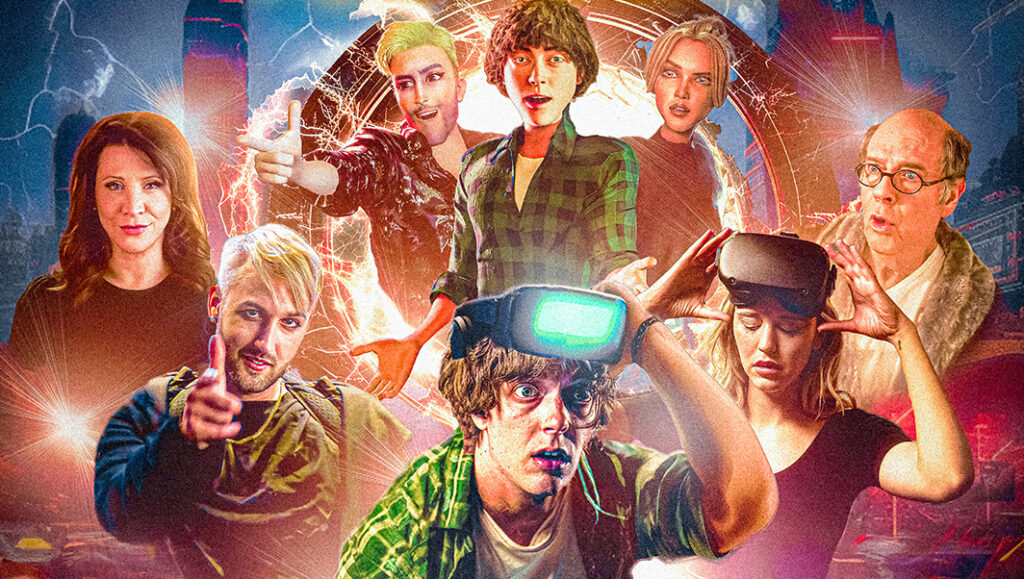Exclusive Interview: L.E. Staiman and Cheston Mizel Bring Audiences to the Metaverse with Their New Film ‘Love Virtually’

L.E. Staiman and Cheston Mizel are the creative masterminds behind the must-see film, Love Virtually.
In a world where the Metaverse has become widely adopted, four couples go to ridiculous lengths to find true love in a virtual world. Love Virtually is a retro future satirical rom-com for the Metaverse era, blending live action and 3D animation as It explores and exposes the absurd reality of our world and where we are heading, while probing life’s deepest questions such as: How does a celebrity find someone who loves them for their true selves? Is it cheating if it’s in VR? and, Is it cheating if it’s with an AI?
Pop Culturalist was lucky enough to speak with L.E. and Cheston about Love Virtually, their collaboration, how the feature defies expectations, why comedy is the perfect medium to tackle timely subject matter, and more.
PC: L.E., it was while working on Cheston’s wife’s film that you approached him about creating a feature. The two of you kept trading ideas back and forth, each one crazier than the last. How did those early conversations manifest into Love Virtually?
L.E.: The first storyline we discussed involved the sandbagging idea with Clarissa and La Monte, and the concept of beautiful people reverse catfishing one another because they want to be appreciated for who they are, not judged by their looks or celebrity status. However, we didn’t think that could carry an entire film. So we decided to explore an ensemble feature.
We thought, “What other ideas work within this alternate or slightly-futuristic world where the metaverse is more widely adopted?” Exactly as you said, we kept trading ideas back and forth and hit this absurd stride that birthed this movie.
PC: Cheston, you were initially adamant about not making another film. What ultimately led to that change of heart?
Cheston: COVID. [laughs] The first film was an exhausting process. It was a very personal documentary, and I hadn’t anticipated making a significant shift to become a filmmaker since I was occupied with other things. I thought I would move on from that idea. Then COVID happened and made everyone reconsider everything. I’ve always enjoyed writing and engaging in entrepreneurial, creative pursuits. Once we got the ball rolling, it took over and kept me sane through an insane time.
PC: L.E., you also have a starring role in the film. As you were co-writing this script, did you know you wanted to act in it as well? How did you settle on playing Kalvin, who’s not the most likable character?
L.E.: I was never supposed to play Kalvin. I initially wrote a different director cameo for myself, intending to play the newscaster. It was meant to be a small, fun cameo. However, after auditioning Henry Dittman for the newscaster role, I realized he was incredibly funny. I decided not to play that role.
A week or two before shooting, we had a long list of actors for Kalvin, but they were unavailable or didn’t want to be typecast. We were running out of options, and Cheston told me he wouldn’t spend more time or money on someone. He said, “Go bleach your hair because I’m not spending any more time on this.” [laughs] So I was somewhat forced into the role, which turned out to be a lot of fun.
PC: Cheston, when you’re working on a micro budget, you don’t necessarily think of or associate animation, which is a huge undertaking. You made that seem so effortless. Was it easy to learn? What was that process like?
Cheston: It was a rabbit hole, and it wasn’t effortless. I started exploring tools at a time when many things are available, which democratized the process. I discovered a software called iClone, not widely used in the industry, making it challenging to find help to take it to the next level. But I managed to grasp the basics of mo-cap, keyframe, avatar creation, and more, especially with iClone and Unreal Engine. Unreal Engine’s marketplace provided environments.
Bringing an avatar to Unreal Engine took time to figure out, but once I found someone to clean up the animation, despite facing issues with mo-cap, we kept pushing through. It did cost money to get it cleaned up, but much less than if we had hired someone from the beginning. It was the only way to get it done.
L.E.: It was really the only way to get it done.
Cheston: Yeah, exactly. It was the only way to get it done, which was kind of crazy. Fortunately, we found people to finish it. There were a couple of scenes we had them do completely when we decided that we needed a scene that does this. It was a very long process, but it gave me something to do at three or four in the morning.
PC: L.E., you have such a star-studded cast for this project. Many of them are well-versed in the comedy genre. As the director and co-writer, how did you create space for our cast to improvise and make their characters their own?
L.E.: That’s a great question. We specifically brought on certain actors, like Peter Gilroy who plays Roddy, to adlib. I’ve worked with him extensively before, and that’s where he shines. I wanted him to bring his own spin to the character of Roddy, and that’s exactly what he did. There was the version on the page and what Peter did, which were quite different.
We definitely gave the actors opportunities to adlib. We would shoot one version as written and then let them adlib to see what they would come up with. The fusion gave us a lot to work with. The challenge was that many actors never met each other. They read lines with me over Zoom calls, so it involved cutting adlibs together that were shot weeks apart and not acted together, making it feel cohesive. Miraculously, things cut together well.
PC: L.E., this is also your feature film debut as a director and Cheston for you as a writer. What was the most surprising part about this experience? What was the biggest takeaway for each of you?
L.E.: That’s a good question.
Cheston: The most surprising part is that we pulled it off. I like to say that we’re nobodies from Nowheresville who punched above our weight and made a film that people will hopefully take seriously and like and pushed it way beyond what anyone would expect from a couple of guys in a basement with mo-cap suits were going to be able to pull off. I think the fact that we pulled it off and it’s been pretty well-received. I think that’s been the biggest shock of it all. It just shows you that just because something seems impossible doesn’t mean it’s not worth doing.
L.E.: The fact that this movie got made and is watchable is pretty surprising with all the challenges that came up. We shot over 600 VFX shots and had close to 40 animated scenes. The fact that it’s cohesive and watchable is pretty surprising.
PC: This film defies expectations. Is there a scene in particular that you’re excited for audiences to see?
L.E: The washing machine scene and the twists that happens there without giving anything away. I love watching people’s reactions to that scene because it’s really gratifying when those little bits work out.
Cheston: One of my favorite scenes is the dining room table scene because it exposes how one relationship can be happening on multiple levels at the same time and how compartmentalized we can get. It’s a revolutionary scene in the way that we think of relationships. It’s an interesting scene, but it’s hard to pick one that encapsulates the whole movie.
PC: The film tackles a lot of timely and universal themes. What do you think comedy, particularly satire, is the perfect genre to tackle this type of storytelling?
L.E.: Comedy is the only safe medium to do that. That and rap music. You can get away with saying all kinds of things that you can’t say in casual conversation in rap and in comedy. With satire, you’re really holding up a mirror to society. This is what the medium is for. It’s not to be malicious. It’s the idea that you can ask hard-hitting societal questions and hold them back to society. An example of that is, “Is this what we value?” There are a lot of interesting questions that come from this, especially in terms of the integration of technology into our lives.
Make sure to follow L.E. on Instagram. Love Virtually is out now wherever you stream movies.


Discussion about this post